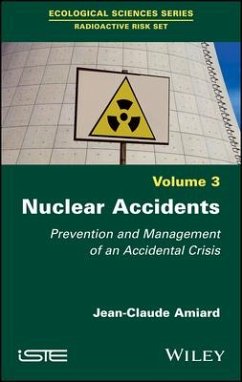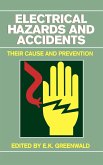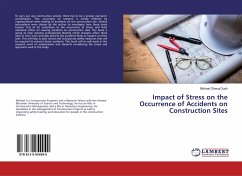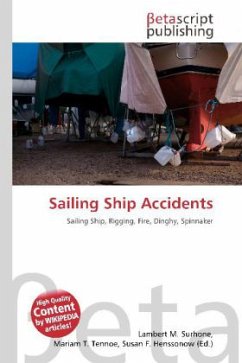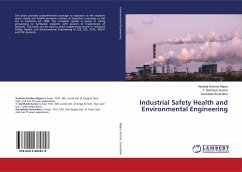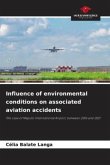- Gebundenes Buch
- Merkliste
- Auf die Merkliste
- Bewerten Bewerten
- Teilen
- Produkt teilen
- Produkterinnerung
- Produkterinnerung
Detailing the estimation and perception of nuclear risk, this book follows military and civilian nuclear accidents, plus the systems put in place by national and international authorities for recording and analyzing feedback. Prevention and anticipation being the best defenses against a nuclear accident, the authorities have also categorized the different types of accidents, and are doing research to better understand and control them. In light of this, this book shows how the authorities take practical measures to protect neighboring populations and limit radioactive contamination of the…mehr
Andere Kunden interessierten sich auch für
![Electrical Hazards and Accidents Electrical Hazards and Accidents]() Electrical Hazards and Accidents190,99 €
Electrical Hazards and Accidents190,99 €![Impact of Stress on the Occurrence of Accidents on Construction Sites Impact of Stress on the Occurrence of Accidents on Construction Sites]() Michael Obeng DuahImpact of Stress on the Occurrence of Accidents on Construction Sites36,99 €
Michael Obeng DuahImpact of Stress on the Occurrence of Accidents on Construction Sites36,99 €![Sailing Ship Accidents Sailing Ship Accidents]() Sailing Ship Accidents19,99 €
Sailing Ship Accidents19,99 €![Work safety in the construction industry: a case study Work safety in the construction industry: a case study]() Loredanna Melyssa Costa de SouzaWork safety in the construction industry: a case study33,99 €
Loredanna Melyssa Costa de SouzaWork safety in the construction industry: a case study33,99 €![Industrial Safety Health and Environmental Engineering Industrial Safety Health and Environmental Engineering]() Venkata Krishna RajaniIndustrial Safety Health and Environmental Engineering47,99 €
Venkata Krishna RajaniIndustrial Safety Health and Environmental Engineering47,99 €![Influence of environmental conditions on associated aviation accidents Influence of environmental conditions on associated aviation accidents]() Célia Balate LangaInfluence of environmental conditions on associated aviation accidents45,99 €
Célia Balate LangaInfluence of environmental conditions on associated aviation accidents45,99 €![The Costs of Construction Accidents The Costs of Construction Accidents]() Kersey Robin PillayThe Costs of Construction Accidents26,99 €
Kersey Robin PillayThe Costs of Construction Accidents26,99 €-
-
-
Detailing the estimation and perception of nuclear risk, this book follows military and civilian nuclear accidents, plus the systems put in place by national and international authorities for recording and analyzing feedback. Prevention and anticipation being the best defenses against a nuclear accident, the authorities have also categorized the different types of accidents, and are doing research to better understand and control them. In light of this, this book shows how the authorities take practical measures to protect neighboring populations and limit radioactive contamination of the environment. France's experience in this arena is well-documented and a chapter of this book is devoted to the fight against terrorist attacks in the nuclear field. Nuclear Accidents is based on scientifically-recognized publications, as well as on reports from the various countries concerned, and the national and international organizations competent in this field (IAEA, WHO, UNSCEAR, IRSN, etc.).
Hinweis: Dieser Artikel kann nur an eine deutsche Lieferadresse ausgeliefert werden.
Hinweis: Dieser Artikel kann nur an eine deutsche Lieferadresse ausgeliefert werden.
Produktdetails
- Produktdetails
- Verlag: Wiley
- Seitenzahl: 394
- Erscheinungstermin: 26. Februar 2020
- Englisch
- Abmessung: 236mm x 157mm x 25mm
- Gewicht: 726g
- ISBN-13: 9781786303356
- ISBN-10: 1786303353
- Artikelnr.: 58293549
- Herstellerkennzeichnung
- Libri GmbH
- Europaallee 1
- 36244 Bad Hersfeld
- gpsr@libri.de
- Verlag: Wiley
- Seitenzahl: 394
- Erscheinungstermin: 26. Februar 2020
- Englisch
- Abmessung: 236mm x 157mm x 25mm
- Gewicht: 726g
- ISBN-13: 9781786303356
- ISBN-10: 1786303353
- Artikelnr.: 58293549
- Herstellerkennzeichnung
- Libri GmbH
- Europaallee 1
- 36244 Bad Hersfeld
- gpsr@libri.de
Jean-Claude Amiard is a State Doctor in Radioecology, Emeritus Research Director at CNRS (University of Nantes) and former Associate Professor in Quebec and China. He is the author of more than 200 publications, 76 books or chapters and 150 papers for international conferences.
Acknowledgments xi
Preface xiii
Chapter 1. Assessment and Perception of Nuclear Risk 1
1.1. Introduction 1
1.2. Danger, exposure, radiotoxicity and risk 4
1.2.1. Identification of radionuclide hazards 5
1.2.2. Contamination of the environment, including the anthroposphere, by
radionuclides 7
1.2.3. Exposure to radiation 11
1.2.4. Collective doses 17
1.3. From dose to adverse effect in non-human organisms (flora and fauna)
17
1.3.1. The harmful effects of ionizing radiation 18
1.3.2. The dose-response relationship 20
1.3.3. Recommended threshold values 22
1.4. From dose to adverse effect in humans 24
1.4.1. Deterministic and stochastic effects 24
1.4.2. Dose-response relationships for average doses: epidemiological
studies 25
1.4.3. Responses to low doses 26
1.5. Radiation protection and recommendations for human irradiation 32
1.6. Risk perception 35
1.6.1. Probability of a future nuclear accident 36
1.6.2. Countries using or renouncing the use of nuclear energy 37
1.6.3. Opinion polls on nuclear power 38
1.6.4. Estimated risk and perceived risk 41
1.7. Conclusion 42
Chapter 2. Lessons from the Past in the Field of Nuclear Accidents 45
2.1. Early signals and late lessons 45
2.2. Structures for disseminating information on radioactive risk 45
2.2.1. Situation from 1945 to 1990 46
2.2.2. Situation from the Chernobyl accident to the present day 47
2.2.3. The example of France 48
2.2.4. Future change? 50
2.3. Feedback (REX) 51
2.3.1. Introduction: what is REX? 51
2.3.2. The overall REX process 52
2.3.3. Causes of REX failure 54
2.4. Lessons from the past 55
2.4.1. Lessons learned from military nuclear activities and accidents 55
2.4.2. Lessons from industrial accidents 57
2.4.3. Medical accidents 72
2.5. Crisis exercises 77
2.5.1. Transnational exercises 77
2.5.2. National exercises 78
2.6. Incident and accident reporting 80
2.6.1. A common severity scale 80
2.6.2. Management of declarations 81
2.6.3. Reporting systems 81
2.6.4. Websites 82
2.7. Conclusion 83
Chapter 3. Research for the Future 85
3.1. Introduction: safety and the main types of accidents 85
3.1.1. Safety history 85
3.1.2. The main safety objectives 86
3.1.3. Defense in depth 87
3.1.4. New research in the field of nuclear safety 88
3.1.5. The aging of nuclear installations 90
3.2. International actions 92
3.2.1. Improving the organization of security at the level of each state 92
3.2.2. The IAEA 94
3.2.3. The NEA 95
3.2.4. The ICRP 98
3.2.5. UNSCEAR 99
3.2.6. The ICRU 100
3.2.7. The IRSN at international level 100
3.3. European actions 101
3.3.1. Euratom 101
3.3.2. Complementary safety assessments (ECS) process 102
3.4. French actions 103
3.5. Advances in nuclear safety 106
3.5.1. Better knowledge of nuclear fuel 107
3.5.2. Better preventing the risk of steam and hydrogen explosions 110
3.5.3. Controlling radionuclide releases 111
3.5.4. Consequences of a fire 112
3.5.5. Knowing more about corium 113
3.5.6. Controlling a water injection into a molten core 115
3.5.7. Mastering electrical distribution systems 115
3.5.8. Improving modeling 116
3.6. Advances in radioecology 118
3.6.1. Determination of the source term 118
3.6.2. Modeling of radionuclide dispersion in the terrestrial environment
119
3.6.3. Modeling of radionuclide dispersion in aquatic environments 120
3.6.4. Modeling of trophic transfer of radionuclides in organisms 121
3.7. Advances in radiation protection 121
3.7.1. Improving the radiological protection system 122
3.7.2. Improving the management of a nuclear accident 125
3.8. Safety research in other types of nuclear installations 128
3.8.1. Cooling pools 128
3.8.2. Spent fuel reprocessing plants 129
3.8.3. Sodium-cooled fast neutron reactors 129
3.8.4. ITER (International Thermonuclear Experimental Reactor) fusion
facility 129
3.8.5. Better understanding of criticality 130
3.9. Advances in the humanities and social sciences 130
3.10. Conclusion 131
Chapter 4. Management of the Emergency Phase of a Nuclear Accident 133
4.1. Introduction 133
4.2. The first actions of the threat and rejection periods 134
4.2.1. Radioactive releases in the event of an accident from a nuclear
reactor 135
4.2.2. Radioactivity measurements during a nuclear accident 136
4.3. Population management in the emergency phase 138
4.3.1. Containment or sheltering of the population 140
4.3.2. Mass evacuation or evacuation of part of the population 141
4.3.3. Distribution of stable iodine tablets 152
4.4. Food supply management 156
4.4.1. Recommended values 156
4.4.2. Regulatory values 158
4.5. Intervention levels for the protection of populations 160
4.5.1. International recommendations 160
4.5.2. The texts of the various states 163
4.6. The organization of crisis management in France 164
4.6.1. Documentation of the ORSEC plan 165
4.6.2. The subdivisions of the ORSEC plan 167
4.6.3. French actors in nuclear crisis management 167
4.6.4. The internal emergency plan 168
4.6.5. The plan particulier d'intervention (PPI, special intervention
plans) 170
4.6.6. Other complementary plans of the PPI 180
4.7. Exiting the emergency phase 182
4.8. Conclusion 183
Chapter 5. Management of the Post-accident Phase 185
5.1. Introduction 185
5.2. The actions to be taken 186
5.2.1. Priority actions to be undertaken 187
5.2.2. Actions during the transitional period 188
5.2.3. Long-term actions 189
5.2.4. Radioactivity measurements following a nuclear accident 190
5.3. Environmental management 191
5.3.1. Management of aquatic environments 191
5.3.2. Management of terrestrial environments 193
5.4. Managing the anthroposphere 195
5.4.1. Decontamination of living areas 196
5.4.2. Nuclear waste management 196
5.4.3. Agricultural management 197
5.4.4. Managing the economy 202
5.4.5. Food supply management 203
5.5. Management of exposed populations 204
5.5.1. Limiting people's exposure to radiation 204
5.5.2. Radiological monitoring of exposed populations 206
5.5.3. Radiological and health monitoring of nuclear workers 208
5.5.4. Health monitoring of exposed populations 208
5.5.5. The return of evacuated populations 209
5.5.6. The experience of local populations in contaminated environments 211
5.5.7. Human dignity 211
5.6. The organization of post-accident management 212
5.6.1. International and European recommendations 212
5.6.2. French doctrine 215
5.7. Conclusion 221
Chapter 6. Terrorist Attacks and Nuclear Security 223
6.1. Introduction 223
6.2. Malicious acts 224
6.2.1. Attempts at radiation aggression 225
6.2.2. The assassination of Alexander Litvinenko 225
6.2.3. Arafat's death 226
6.2.4. Overflights and intrusions into nuclear facilities 228
6.3. Possible terrorist attacks 228
6.3.1. The use of a nuclear weapon 229
6.3.2. The use of a "dirty" bomb 229
6.3.3. Attack on a nuclear installation or transport 231
6.3.4. The release of radioactive material 231
6.3.5. Cyber-attacks 232
6.4. The consequences of a terrorist act in the nuclear field 233
6.4.1. The health consequences 234
6.4.2. The psychological consequences 236
6.4.3. Countermeasures in the event of terrorist attacks 237
6.5. Organizational preparation for a terrorist threat 240
6.6. Prevention of terrorist risk in the nuclear field 242
6.6.1. Nuclear non-proliferation 242
6.6.2. Trafficking in military weapons and radionuclides 245
6.6.3. The actions to be taken 247
6.6.4. The limitation of nuclear materials 248
6.7. Conclusion 249
Chapter 7. General Conclusions 253
7.1. The probability of military and civil accidents 253
7.1.1. Nuclear risks and probabilities 253
7.1.2. The causes of accidents 254
7.2. The environmental consequences of accidents 255
7.3. The health consequences of accidents 256
7.4. The economic consequences of accidents 260
7.5. Prevention of nuclear accidents 262
7.6. Management of the emergency and post-accident phases 264
7.7. Perception of nuclear risk 264
7.8. Public information 265
References 269
Acronyms and Abbreviations 339
Index 355
Preface xiii
Chapter 1. Assessment and Perception of Nuclear Risk 1
1.1. Introduction 1
1.2. Danger, exposure, radiotoxicity and risk 4
1.2.1. Identification of radionuclide hazards 5
1.2.2. Contamination of the environment, including the anthroposphere, by
radionuclides 7
1.2.3. Exposure to radiation 11
1.2.4. Collective doses 17
1.3. From dose to adverse effect in non-human organisms (flora and fauna)
17
1.3.1. The harmful effects of ionizing radiation 18
1.3.2. The dose-response relationship 20
1.3.3. Recommended threshold values 22
1.4. From dose to adverse effect in humans 24
1.4.1. Deterministic and stochastic effects 24
1.4.2. Dose-response relationships for average doses: epidemiological
studies 25
1.4.3. Responses to low doses 26
1.5. Radiation protection and recommendations for human irradiation 32
1.6. Risk perception 35
1.6.1. Probability of a future nuclear accident 36
1.6.2. Countries using or renouncing the use of nuclear energy 37
1.6.3. Opinion polls on nuclear power 38
1.6.4. Estimated risk and perceived risk 41
1.7. Conclusion 42
Chapter 2. Lessons from the Past in the Field of Nuclear Accidents 45
2.1. Early signals and late lessons 45
2.2. Structures for disseminating information on radioactive risk 45
2.2.1. Situation from 1945 to 1990 46
2.2.2. Situation from the Chernobyl accident to the present day 47
2.2.3. The example of France 48
2.2.4. Future change? 50
2.3. Feedback (REX) 51
2.3.1. Introduction: what is REX? 51
2.3.2. The overall REX process 52
2.3.3. Causes of REX failure 54
2.4. Lessons from the past 55
2.4.1. Lessons learned from military nuclear activities and accidents 55
2.4.2. Lessons from industrial accidents 57
2.4.3. Medical accidents 72
2.5. Crisis exercises 77
2.5.1. Transnational exercises 77
2.5.2. National exercises 78
2.6. Incident and accident reporting 80
2.6.1. A common severity scale 80
2.6.2. Management of declarations 81
2.6.3. Reporting systems 81
2.6.4. Websites 82
2.7. Conclusion 83
Chapter 3. Research for the Future 85
3.1. Introduction: safety and the main types of accidents 85
3.1.1. Safety history 85
3.1.2. The main safety objectives 86
3.1.3. Defense in depth 87
3.1.4. New research in the field of nuclear safety 88
3.1.5. The aging of nuclear installations 90
3.2. International actions 92
3.2.1. Improving the organization of security at the level of each state 92
3.2.2. The IAEA 94
3.2.3. The NEA 95
3.2.4. The ICRP 98
3.2.5. UNSCEAR 99
3.2.6. The ICRU 100
3.2.7. The IRSN at international level 100
3.3. European actions 101
3.3.1. Euratom 101
3.3.2. Complementary safety assessments (ECS) process 102
3.4. French actions 103
3.5. Advances in nuclear safety 106
3.5.1. Better knowledge of nuclear fuel 107
3.5.2. Better preventing the risk of steam and hydrogen explosions 110
3.5.3. Controlling radionuclide releases 111
3.5.4. Consequences of a fire 112
3.5.5. Knowing more about corium 113
3.5.6. Controlling a water injection into a molten core 115
3.5.7. Mastering electrical distribution systems 115
3.5.8. Improving modeling 116
3.6. Advances in radioecology 118
3.6.1. Determination of the source term 118
3.6.2. Modeling of radionuclide dispersion in the terrestrial environment
119
3.6.3. Modeling of radionuclide dispersion in aquatic environments 120
3.6.4. Modeling of trophic transfer of radionuclides in organisms 121
3.7. Advances in radiation protection 121
3.7.1. Improving the radiological protection system 122
3.7.2. Improving the management of a nuclear accident 125
3.8. Safety research in other types of nuclear installations 128
3.8.1. Cooling pools 128
3.8.2. Spent fuel reprocessing plants 129
3.8.3. Sodium-cooled fast neutron reactors 129
3.8.4. ITER (International Thermonuclear Experimental Reactor) fusion
facility 129
3.8.5. Better understanding of criticality 130
3.9. Advances in the humanities and social sciences 130
3.10. Conclusion 131
Chapter 4. Management of the Emergency Phase of a Nuclear Accident 133
4.1. Introduction 133
4.2. The first actions of the threat and rejection periods 134
4.2.1. Radioactive releases in the event of an accident from a nuclear
reactor 135
4.2.2. Radioactivity measurements during a nuclear accident 136
4.3. Population management in the emergency phase 138
4.3.1. Containment or sheltering of the population 140
4.3.2. Mass evacuation or evacuation of part of the population 141
4.3.3. Distribution of stable iodine tablets 152
4.4. Food supply management 156
4.4.1. Recommended values 156
4.4.2. Regulatory values 158
4.5. Intervention levels for the protection of populations 160
4.5.1. International recommendations 160
4.5.2. The texts of the various states 163
4.6. The organization of crisis management in France 164
4.6.1. Documentation of the ORSEC plan 165
4.6.2. The subdivisions of the ORSEC plan 167
4.6.3. French actors in nuclear crisis management 167
4.6.4. The internal emergency plan 168
4.6.5. The plan particulier d'intervention (PPI, special intervention
plans) 170
4.6.6. Other complementary plans of the PPI 180
4.7. Exiting the emergency phase 182
4.8. Conclusion 183
Chapter 5. Management of the Post-accident Phase 185
5.1. Introduction 185
5.2. The actions to be taken 186
5.2.1. Priority actions to be undertaken 187
5.2.2. Actions during the transitional period 188
5.2.3. Long-term actions 189
5.2.4. Radioactivity measurements following a nuclear accident 190
5.3. Environmental management 191
5.3.1. Management of aquatic environments 191
5.3.2. Management of terrestrial environments 193
5.4. Managing the anthroposphere 195
5.4.1. Decontamination of living areas 196
5.4.2. Nuclear waste management 196
5.4.3. Agricultural management 197
5.4.4. Managing the economy 202
5.4.5. Food supply management 203
5.5. Management of exposed populations 204
5.5.1. Limiting people's exposure to radiation 204
5.5.2. Radiological monitoring of exposed populations 206
5.5.3. Radiological and health monitoring of nuclear workers 208
5.5.4. Health monitoring of exposed populations 208
5.5.5. The return of evacuated populations 209
5.5.6. The experience of local populations in contaminated environments 211
5.5.7. Human dignity 211
5.6. The organization of post-accident management 212
5.6.1. International and European recommendations 212
5.6.2. French doctrine 215
5.7. Conclusion 221
Chapter 6. Terrorist Attacks and Nuclear Security 223
6.1. Introduction 223
6.2. Malicious acts 224
6.2.1. Attempts at radiation aggression 225
6.2.2. The assassination of Alexander Litvinenko 225
6.2.3. Arafat's death 226
6.2.4. Overflights and intrusions into nuclear facilities 228
6.3. Possible terrorist attacks 228
6.3.1. The use of a nuclear weapon 229
6.3.2. The use of a "dirty" bomb 229
6.3.3. Attack on a nuclear installation or transport 231
6.3.4. The release of radioactive material 231
6.3.5. Cyber-attacks 232
6.4. The consequences of a terrorist act in the nuclear field 233
6.4.1. The health consequences 234
6.4.2. The psychological consequences 236
6.4.3. Countermeasures in the event of terrorist attacks 237
6.5. Organizational preparation for a terrorist threat 240
6.6. Prevention of terrorist risk in the nuclear field 242
6.6.1. Nuclear non-proliferation 242
6.6.2. Trafficking in military weapons and radionuclides 245
6.6.3. The actions to be taken 247
6.6.4. The limitation of nuclear materials 248
6.7. Conclusion 249
Chapter 7. General Conclusions 253
7.1. The probability of military and civil accidents 253
7.1.1. Nuclear risks and probabilities 253
7.1.2. The causes of accidents 254
7.2. The environmental consequences of accidents 255
7.3. The health consequences of accidents 256
7.4. The economic consequences of accidents 260
7.5. Prevention of nuclear accidents 262
7.6. Management of the emergency and post-accident phases 264
7.7. Perception of nuclear risk 264
7.8. Public information 265
References 269
Acronyms and Abbreviations 339
Index 355
Acknowledgments xi
Preface xiii
Chapter 1. Assessment and Perception of Nuclear Risk 1
1.1. Introduction 1
1.2. Danger, exposure, radiotoxicity and risk 4
1.2.1. Identification of radionuclide hazards 5
1.2.2. Contamination of the environment, including the anthroposphere, by
radionuclides 7
1.2.3. Exposure to radiation 11
1.2.4. Collective doses 17
1.3. From dose to adverse effect in non-human organisms (flora and fauna)
17
1.3.1. The harmful effects of ionizing radiation 18
1.3.2. The dose-response relationship 20
1.3.3. Recommended threshold values 22
1.4. From dose to adverse effect in humans 24
1.4.1. Deterministic and stochastic effects 24
1.4.2. Dose-response relationships for average doses: epidemiological
studies 25
1.4.3. Responses to low doses 26
1.5. Radiation protection and recommendations for human irradiation 32
1.6. Risk perception 35
1.6.1. Probability of a future nuclear accident 36
1.6.2. Countries using or renouncing the use of nuclear energy 37
1.6.3. Opinion polls on nuclear power 38
1.6.4. Estimated risk and perceived risk 41
1.7. Conclusion 42
Chapter 2. Lessons from the Past in the Field of Nuclear Accidents 45
2.1. Early signals and late lessons 45
2.2. Structures for disseminating information on radioactive risk 45
2.2.1. Situation from 1945 to 1990 46
2.2.2. Situation from the Chernobyl accident to the present day 47
2.2.3. The example of France 48
2.2.4. Future change? 50
2.3. Feedback (REX) 51
2.3.1. Introduction: what is REX? 51
2.3.2. The overall REX process 52
2.3.3. Causes of REX failure 54
2.4. Lessons from the past 55
2.4.1. Lessons learned from military nuclear activities and accidents 55
2.4.2. Lessons from industrial accidents 57
2.4.3. Medical accidents 72
2.5. Crisis exercises 77
2.5.1. Transnational exercises 77
2.5.2. National exercises 78
2.6. Incident and accident reporting 80
2.6.1. A common severity scale 80
2.6.2. Management of declarations 81
2.6.3. Reporting systems 81
2.6.4. Websites 82
2.7. Conclusion 83
Chapter 3. Research for the Future 85
3.1. Introduction: safety and the main types of accidents 85
3.1.1. Safety history 85
3.1.2. The main safety objectives 86
3.1.3. Defense in depth 87
3.1.4. New research in the field of nuclear safety 88
3.1.5. The aging of nuclear installations 90
3.2. International actions 92
3.2.1. Improving the organization of security at the level of each state 92
3.2.2. The IAEA 94
3.2.3. The NEA 95
3.2.4. The ICRP 98
3.2.5. UNSCEAR 99
3.2.6. The ICRU 100
3.2.7. The IRSN at international level 100
3.3. European actions 101
3.3.1. Euratom 101
3.3.2. Complementary safety assessments (ECS) process 102
3.4. French actions 103
3.5. Advances in nuclear safety 106
3.5.1. Better knowledge of nuclear fuel 107
3.5.2. Better preventing the risk of steam and hydrogen explosions 110
3.5.3. Controlling radionuclide releases 111
3.5.4. Consequences of a fire 112
3.5.5. Knowing more about corium 113
3.5.6. Controlling a water injection into a molten core 115
3.5.7. Mastering electrical distribution systems 115
3.5.8. Improving modeling 116
3.6. Advances in radioecology 118
3.6.1. Determination of the source term 118
3.6.2. Modeling of radionuclide dispersion in the terrestrial environment
119
3.6.3. Modeling of radionuclide dispersion in aquatic environments 120
3.6.4. Modeling of trophic transfer of radionuclides in organisms 121
3.7. Advances in radiation protection 121
3.7.1. Improving the radiological protection system 122
3.7.2. Improving the management of a nuclear accident 125
3.8. Safety research in other types of nuclear installations 128
3.8.1. Cooling pools 128
3.8.2. Spent fuel reprocessing plants 129
3.8.3. Sodium-cooled fast neutron reactors 129
3.8.4. ITER (International Thermonuclear Experimental Reactor) fusion
facility 129
3.8.5. Better understanding of criticality 130
3.9. Advances in the humanities and social sciences 130
3.10. Conclusion 131
Chapter 4. Management of the Emergency Phase of a Nuclear Accident 133
4.1. Introduction 133
4.2. The first actions of the threat and rejection periods 134
4.2.1. Radioactive releases in the event of an accident from a nuclear
reactor 135
4.2.2. Radioactivity measurements during a nuclear accident 136
4.3. Population management in the emergency phase 138
4.3.1. Containment or sheltering of the population 140
4.3.2. Mass evacuation or evacuation of part of the population 141
4.3.3. Distribution of stable iodine tablets 152
4.4. Food supply management 156
4.4.1. Recommended values 156
4.4.2. Regulatory values 158
4.5. Intervention levels for the protection of populations 160
4.5.1. International recommendations 160
4.5.2. The texts of the various states 163
4.6. The organization of crisis management in France 164
4.6.1. Documentation of the ORSEC plan 165
4.6.2. The subdivisions of the ORSEC plan 167
4.6.3. French actors in nuclear crisis management 167
4.6.4. The internal emergency plan 168
4.6.5. The plan particulier d'intervention (PPI, special intervention
plans) 170
4.6.6. Other complementary plans of the PPI 180
4.7. Exiting the emergency phase 182
4.8. Conclusion 183
Chapter 5. Management of the Post-accident Phase 185
5.1. Introduction 185
5.2. The actions to be taken 186
5.2.1. Priority actions to be undertaken 187
5.2.2. Actions during the transitional period 188
5.2.3. Long-term actions 189
5.2.4. Radioactivity measurements following a nuclear accident 190
5.3. Environmental management 191
5.3.1. Management of aquatic environments 191
5.3.2. Management of terrestrial environments 193
5.4. Managing the anthroposphere 195
5.4.1. Decontamination of living areas 196
5.4.2. Nuclear waste management 196
5.4.3. Agricultural management 197
5.4.4. Managing the economy 202
5.4.5. Food supply management 203
5.5. Management of exposed populations 204
5.5.1. Limiting people's exposure to radiation 204
5.5.2. Radiological monitoring of exposed populations 206
5.5.3. Radiological and health monitoring of nuclear workers 208
5.5.4. Health monitoring of exposed populations 208
5.5.5. The return of evacuated populations 209
5.5.6. The experience of local populations in contaminated environments 211
5.5.7. Human dignity 211
5.6. The organization of post-accident management 212
5.6.1. International and European recommendations 212
5.6.2. French doctrine 215
5.7. Conclusion 221
Chapter 6. Terrorist Attacks and Nuclear Security 223
6.1. Introduction 223
6.2. Malicious acts 224
6.2.1. Attempts at radiation aggression 225
6.2.2. The assassination of Alexander Litvinenko 225
6.2.3. Arafat's death 226
6.2.4. Overflights and intrusions into nuclear facilities 228
6.3. Possible terrorist attacks 228
6.3.1. The use of a nuclear weapon 229
6.3.2. The use of a "dirty" bomb 229
6.3.3. Attack on a nuclear installation or transport 231
6.3.4. The release of radioactive material 231
6.3.5. Cyber-attacks 232
6.4. The consequences of a terrorist act in the nuclear field 233
6.4.1. The health consequences 234
6.4.2. The psychological consequences 236
6.4.3. Countermeasures in the event of terrorist attacks 237
6.5. Organizational preparation for a terrorist threat 240
6.6. Prevention of terrorist risk in the nuclear field 242
6.6.1. Nuclear non-proliferation 242
6.6.2. Trafficking in military weapons and radionuclides 245
6.6.3. The actions to be taken 247
6.6.4. The limitation of nuclear materials 248
6.7. Conclusion 249
Chapter 7. General Conclusions 253
7.1. The probability of military and civil accidents 253
7.1.1. Nuclear risks and probabilities 253
7.1.2. The causes of accidents 254
7.2. The environmental consequences of accidents 255
7.3. The health consequences of accidents 256
7.4. The economic consequences of accidents 260
7.5. Prevention of nuclear accidents 262
7.6. Management of the emergency and post-accident phases 264
7.7. Perception of nuclear risk 264
7.8. Public information 265
References 269
Acronyms and Abbreviations 339
Index 355
Preface xiii
Chapter 1. Assessment and Perception of Nuclear Risk 1
1.1. Introduction 1
1.2. Danger, exposure, radiotoxicity and risk 4
1.2.1. Identification of radionuclide hazards 5
1.2.2. Contamination of the environment, including the anthroposphere, by
radionuclides 7
1.2.3. Exposure to radiation 11
1.2.4. Collective doses 17
1.3. From dose to adverse effect in non-human organisms (flora and fauna)
17
1.3.1. The harmful effects of ionizing radiation 18
1.3.2. The dose-response relationship 20
1.3.3. Recommended threshold values 22
1.4. From dose to adverse effect in humans 24
1.4.1. Deterministic and stochastic effects 24
1.4.2. Dose-response relationships for average doses: epidemiological
studies 25
1.4.3. Responses to low doses 26
1.5. Radiation protection and recommendations for human irradiation 32
1.6. Risk perception 35
1.6.1. Probability of a future nuclear accident 36
1.6.2. Countries using or renouncing the use of nuclear energy 37
1.6.3. Opinion polls on nuclear power 38
1.6.4. Estimated risk and perceived risk 41
1.7. Conclusion 42
Chapter 2. Lessons from the Past in the Field of Nuclear Accidents 45
2.1. Early signals and late lessons 45
2.2. Structures for disseminating information on radioactive risk 45
2.2.1. Situation from 1945 to 1990 46
2.2.2. Situation from the Chernobyl accident to the present day 47
2.2.3. The example of France 48
2.2.4. Future change? 50
2.3. Feedback (REX) 51
2.3.1. Introduction: what is REX? 51
2.3.2. The overall REX process 52
2.3.3. Causes of REX failure 54
2.4. Lessons from the past 55
2.4.1. Lessons learned from military nuclear activities and accidents 55
2.4.2. Lessons from industrial accidents 57
2.4.3. Medical accidents 72
2.5. Crisis exercises 77
2.5.1. Transnational exercises 77
2.5.2. National exercises 78
2.6. Incident and accident reporting 80
2.6.1. A common severity scale 80
2.6.2. Management of declarations 81
2.6.3. Reporting systems 81
2.6.4. Websites 82
2.7. Conclusion 83
Chapter 3. Research for the Future 85
3.1. Introduction: safety and the main types of accidents 85
3.1.1. Safety history 85
3.1.2. The main safety objectives 86
3.1.3. Defense in depth 87
3.1.4. New research in the field of nuclear safety 88
3.1.5. The aging of nuclear installations 90
3.2. International actions 92
3.2.1. Improving the organization of security at the level of each state 92
3.2.2. The IAEA 94
3.2.3. The NEA 95
3.2.4. The ICRP 98
3.2.5. UNSCEAR 99
3.2.6. The ICRU 100
3.2.7. The IRSN at international level 100
3.3. European actions 101
3.3.1. Euratom 101
3.3.2. Complementary safety assessments (ECS) process 102
3.4. French actions 103
3.5. Advances in nuclear safety 106
3.5.1. Better knowledge of nuclear fuel 107
3.5.2. Better preventing the risk of steam and hydrogen explosions 110
3.5.3. Controlling radionuclide releases 111
3.5.4. Consequences of a fire 112
3.5.5. Knowing more about corium 113
3.5.6. Controlling a water injection into a molten core 115
3.5.7. Mastering electrical distribution systems 115
3.5.8. Improving modeling 116
3.6. Advances in radioecology 118
3.6.1. Determination of the source term 118
3.6.2. Modeling of radionuclide dispersion in the terrestrial environment
119
3.6.3. Modeling of radionuclide dispersion in aquatic environments 120
3.6.4. Modeling of trophic transfer of radionuclides in organisms 121
3.7. Advances in radiation protection 121
3.7.1. Improving the radiological protection system 122
3.7.2. Improving the management of a nuclear accident 125
3.8. Safety research in other types of nuclear installations 128
3.8.1. Cooling pools 128
3.8.2. Spent fuel reprocessing plants 129
3.8.3. Sodium-cooled fast neutron reactors 129
3.8.4. ITER (International Thermonuclear Experimental Reactor) fusion
facility 129
3.8.5. Better understanding of criticality 130
3.9. Advances in the humanities and social sciences 130
3.10. Conclusion 131
Chapter 4. Management of the Emergency Phase of a Nuclear Accident 133
4.1. Introduction 133
4.2. The first actions of the threat and rejection periods 134
4.2.1. Radioactive releases in the event of an accident from a nuclear
reactor 135
4.2.2. Radioactivity measurements during a nuclear accident 136
4.3. Population management in the emergency phase 138
4.3.1. Containment or sheltering of the population 140
4.3.2. Mass evacuation or evacuation of part of the population 141
4.3.3. Distribution of stable iodine tablets 152
4.4. Food supply management 156
4.4.1. Recommended values 156
4.4.2. Regulatory values 158
4.5. Intervention levels for the protection of populations 160
4.5.1. International recommendations 160
4.5.2. The texts of the various states 163
4.6. The organization of crisis management in France 164
4.6.1. Documentation of the ORSEC plan 165
4.6.2. The subdivisions of the ORSEC plan 167
4.6.3. French actors in nuclear crisis management 167
4.6.4. The internal emergency plan 168
4.6.5. The plan particulier d'intervention (PPI, special intervention
plans) 170
4.6.6. Other complementary plans of the PPI 180
4.7. Exiting the emergency phase 182
4.8. Conclusion 183
Chapter 5. Management of the Post-accident Phase 185
5.1. Introduction 185
5.2. The actions to be taken 186
5.2.1. Priority actions to be undertaken 187
5.2.2. Actions during the transitional period 188
5.2.3. Long-term actions 189
5.2.4. Radioactivity measurements following a nuclear accident 190
5.3. Environmental management 191
5.3.1. Management of aquatic environments 191
5.3.2. Management of terrestrial environments 193
5.4. Managing the anthroposphere 195
5.4.1. Decontamination of living areas 196
5.4.2. Nuclear waste management 196
5.4.3. Agricultural management 197
5.4.4. Managing the economy 202
5.4.5. Food supply management 203
5.5. Management of exposed populations 204
5.5.1. Limiting people's exposure to radiation 204
5.5.2. Radiological monitoring of exposed populations 206
5.5.3. Radiological and health monitoring of nuclear workers 208
5.5.4. Health monitoring of exposed populations 208
5.5.5. The return of evacuated populations 209
5.5.6. The experience of local populations in contaminated environments 211
5.5.7. Human dignity 211
5.6. The organization of post-accident management 212
5.6.1. International and European recommendations 212
5.6.2. French doctrine 215
5.7. Conclusion 221
Chapter 6. Terrorist Attacks and Nuclear Security 223
6.1. Introduction 223
6.2. Malicious acts 224
6.2.1. Attempts at radiation aggression 225
6.2.2. The assassination of Alexander Litvinenko 225
6.2.3. Arafat's death 226
6.2.4. Overflights and intrusions into nuclear facilities 228
6.3. Possible terrorist attacks 228
6.3.1. The use of a nuclear weapon 229
6.3.2. The use of a "dirty" bomb 229
6.3.3. Attack on a nuclear installation or transport 231
6.3.4. The release of radioactive material 231
6.3.5. Cyber-attacks 232
6.4. The consequences of a terrorist act in the nuclear field 233
6.4.1. The health consequences 234
6.4.2. The psychological consequences 236
6.4.3. Countermeasures in the event of terrorist attacks 237
6.5. Organizational preparation for a terrorist threat 240
6.6. Prevention of terrorist risk in the nuclear field 242
6.6.1. Nuclear non-proliferation 242
6.6.2. Trafficking in military weapons and radionuclides 245
6.6.3. The actions to be taken 247
6.6.4. The limitation of nuclear materials 248
6.7. Conclusion 249
Chapter 7. General Conclusions 253
7.1. The probability of military and civil accidents 253
7.1.1. Nuclear risks and probabilities 253
7.1.2. The causes of accidents 254
7.2. The environmental consequences of accidents 255
7.3. The health consequences of accidents 256
7.4. The economic consequences of accidents 260
7.5. Prevention of nuclear accidents 262
7.6. Management of the emergency and post-accident phases 264
7.7. Perception of nuclear risk 264
7.8. Public information 265
References 269
Acronyms and Abbreviations 339
Index 355

